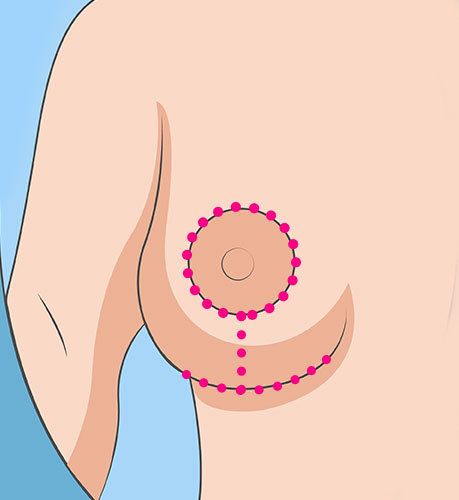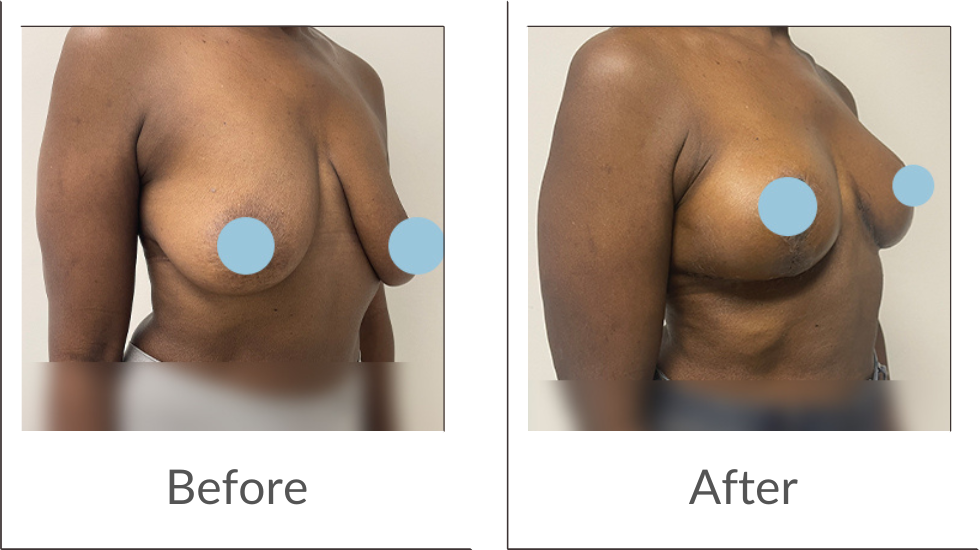Mastopexy
Breast Lift
Breast lift surgery, also known as mastopexy, is a procedure designed to elevate and reshape sagging breasts for a more youthful and perky appearance. Over time, factors such as aging, pregnancy, weight fluctuations, or genetics can cause breasts to lose their shape and firmness. A breast lift restores a natural contour by removing excess skin, reshaping the breast tissue, and repositioning the nipple to create a balanced, lifted look.

What are Some of the Causes of Sagging Breasts?
Breasts can change due to a number of factors. Like facial skin, breast skin loses much of its elasticity with age, the ligaments that hold the breasts begin to weaken, and gravity takes a toll, causing breast tissue to become lax and saggy. Some women may find that their breasts become stretched during pregnancy and breastfeeding, producing loose skin when they shrink back to their original size. Weight loss and menopause may also contribute to this condition. Some women also experience breast ptosis following breast implant removal, and a breast lift is often recommended for women who choose to remove their implants without replacement. Breast ptosis is usually graded on a scale from mild to severe, which measures the nipple location is relation to the inframammary fold, or breast crease.
Benefits of Breast Lift Surgery
Breast lift surgery is ideal for those looking to achieve natural, long-lasting results and feel more confident in their body. At Clinic 360, our experienced surgeons work closely with you to ensure your results align with your aesthetic goals and personal needs.
• Youthful Contour: Restores a perky, lifted shape to the breasts, helping you regain a more youthful silhouette.
• Improved Symmetry: Corrects uneven breasts and realigns nipples for a more balanced appearance.
• Enhanced Confidence: Boosts self-esteem and comfort in clothing, especially bras, swimsuits, and fitted attire.
• Rejuvenated Appearance: Eliminates the drooping or deflated look caused by aging or life changes.
• No Change in Volume (Unless Desired): Focuses on reshaping and lifting the breasts without significantly altering their size, although it can be combined with augmentation or reduction for customized results.
Types of Breast Lifts
Breast lift techniques vary depending on the degree of sagging (ptosis), the desired outcome, and the patient’s unique anatomy. Each type of breast lift involves different incision patterns to achieve the best results for individual needs. Here’s an overview of the main types of breast lifts, the incision methods used, and the ideal candidates for each:

Crescent Lift
- Incision: A small crescent-shaped incision is made along the upper edge of the areola.
- Best for: Patients with mild sagging (minimal ptosis) or who want a slight elevation.
- Details: This technique provides a subtle lift and is often used in combination with breast augmentation to add volume while making minor adjustments to nipple positioning.

Peri-Areolar (Donut) Lift
- Incision: A circular incision is made around the areola.
- Best for: Patients with mild to moderate sagging or who wish to reduce the size of the areola.
- Details: This method allows for modest reshaping and lifting. The scar blends naturally with the edge of the areola, making it discreet.

Vertical (Lollipop) Lift
- Incision: A circular incision around the areola with a vertical incision running down to the breast crease (hence the “lollipop” shape).
- Best for: Patients with moderate sagging and those seeking more dramatic reshaping without an extended incision along the breast crease.
- Details: This technique reshapes the breast tissue, improves projection, and provides noticeable lifting while maintaining a natural contour.

Anchor Lift (Inverted-T Lift)
- Incision: Combines a circular incision around the areola, a vertical incision down to the breast crease, and a horizontal incision along the breast crease.
- Best for: Patients with significant sagging or those with a large amount of excess skin, often after major weight loss or pregnancy.
- Details: This method allows for maximum lift and reshaping. It’s also ideal for correcting significant asymmetry or repositioning nipples that are far below the breast fold.
Let’s See
Breast Lift Before & After Photos

Combining Breast Lift with Breast Augmentation or Explant
For many women, a breast lift can be combined with breast augmentation or breast implant removal (explant) to achieve their desired results. This approach allows patients to address multiple concerns in a single procedure, such as enhancing volume, reshaping the breasts, or restoring a more youthful contour after implant removal. Combining these procedures can save recovery time and provide comprehensive results tailored to your aesthetic goals. If you’re considering adding implants for fuller, more symmetrical breasts, learn more on our Breast Augmentation with Lift page. Alternatively, if you’re ready to remove or replace your implants, visit our Breast Explant page to explore your options.
Breast Lift Surgery Overview
A breast lift procedure typically lasts between 1 to 4 hours, depending on the complexity of the surgery and whether additional procedures, such as breast augmentation, are being performed simultaneously. General anesthesia is commonly used during the surgery. After the procedure, most surgeons recommend wearing a compression garment to reduce swelling and fluid buildup. Additionally, you may be fitted with surgical drains, which are usually removed within a few days. It’s normal to experience minor pain, bruising, swelling, and numbness, which generally subside within a few weeks. Most patients can return to work approximately one week after the surgery, but it’s crucial to avoid strenuous activity and heavy lifting for 4–6 weeks.
What to Expect After Breast Lift Surgery
While results are typically noticeable immediately after the procedure, it can take several weeks to months for the breasts to settle into their final position. Scarring is to be expected; although scars will fade over time, some may remain visible. It’s also important to note that a breast lift cannot stop the natural effects of aging, and the results may diminish over time. Patients are often advised to complete pregnancy and breastfeeding before undergoing a breast lift, as these events can lead to a recurrence of ptosis (sagging), potentially reversing the benefits of the procedure.
Breast Lift Surgery Risks
Because it is a surgical procedure, a breast lift carries all the risks associated with surgery, including bleeding, scarring, infection, and the possibility of adverse reaction to anaesthesia. Additional risks specific to breast lift include loss of sensitivity, nipple necrosis, or loss of breastfeeding ability. These complications are rare in healthy individuals.
